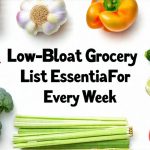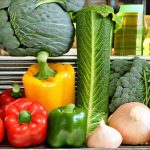Nausea can be debilitating, turning simple tasks like preparing meals into overwhelming challenges. It’s often associated with various conditions – pregnancy, medication side effects, migraine, anxiety, food sensitivities, or even just a temporary upset stomach – but regardless of the cause, finding foods you can tolerate is paramount. Many individuals experiencing nausea find their usual dietary staples suddenly repulsive or difficult to keep down. This isn’t merely about avoiding strong smells or tastes; it’s often about how easily your digestive system can process different foods. A carefully curated grocery list focusing on bland, easy-to-digest ingredients becomes a lifeline during these times, offering not just sustenance but also a degree of control and comfort when everything else feels out of sorts.
The key to building this nausea-safe list isn’t about deprivation; it’s about smart substitution. It’s about understanding which foods are generally easier on the stomach and proactively choosing those options while temporarily minimizing potentially triggering items. This approach acknowledges that dietary needs change with your condition, and prioritizing gentle nourishment is crucial for recovery or management of symptoms. Think less about what you can’t eat and more about nourishing your body with foods it will readily accept, allowing you to regain strength and energy even when nausea looms large. It’s also vital to remember that individual tolerances vary significantly; what works wonders for one person might not work for another, so experimentation (carefully) is often necessary. If planning grocery lists feels impossible, start small and focus on one manageable item at a time.
Understanding Digestive Ease
The core principle behind a nausea-safe diet revolves around minimizing digestive effort. When you’re nauseous, your digestive system is already stressed and potentially hypersensitive. Introducing foods that require extensive processing – high in fat, fiber, or spice – can exacerbate the problem. Easy digestibility means less work for your stomach and intestines, reducing the likelihood of triggering nausea or discomfort. This doesn’t mean eliminating all flavorful food forever; it simply means prioritizing gentler options during periods of acute sensitivity.
Foods that are typically well-tolerated include those that are low in fat, relatively bland in flavor, and easily broken down by digestive enzymes. Think boiled or steamed foods rather than fried or heavily seasoned ones. Simple carbohydrates like plain toast, crackers, or rice are often good starting points because they’re quickly absorbed and don’t put a significant burden on the digestive system. Protein should be lean and in small portions – think poached chicken or white fish – as large amounts of protein can sometimes be harder to digest. Avoiding excessive fiber is also important, as it can increase gut motility and potentially worsen nausea. Consider how you can choose simple dishes when preparing your meals.
The BRAT diet (Bananas, Rice, Applesauce, Toast) has long been a go-to recommendation for digestive upset, and while it’s not a long-term solution, it provides a useful framework. It focuses on easily digestible foods that are gentle on the stomach and can help to solidify stool if diarrhea is also present. However, it’s important to expand beyond the BRAT diet as soon as you can tolerate more options, ensuring you receive adequate nutrition. A prolonged exclusive diet of these few items isn’t nutritionally sufficient.
Building Your Grocery List: Core Components
The foundation of your nausea-safe grocery list should consist of foods that are consistently easy to digest and unlikely to cause irritation. This includes a variety of simple carbohydrates, lean proteins, and mild fruits and vegetables.
- Plain Crackers (saltines or similar): Excellent for settling the stomach, especially first thing in the morning.
- White Rice: Easily digestible and provides a source of energy. Opt for plain white rice over brown rice due to its lower fiber content.
- Bananas: Provide potassium, which can be depleted during vomiting, and are gentle on the stomach. Look for ripe but not overly ripe bananas.
- Applesauce (unsweetened): A good source of pectin, a soluble fiber that may help regulate bowel movements. Ensure it’s unsweetened to avoid added sugar.
- Toast (white bread): Similar to crackers, toast can be soothing and easily tolerated. Avoid whole wheat or multigrain options initially.
- Chicken Broth: Hydrating and provides electrolytes. Choose low-sodium varieties if possible.
- Lean Chicken Breast/White Fish: Good sources of protein that are relatively easy to digest when prepared simply (boiled, steamed, or poached).
When selecting proteins, prioritize those that aren’t heavily marbled with fat. Avoid fried foods at all costs. Similarly, for fruits and vegetables, cooked options are often better tolerated than raw ones, as cooking softens the fiber and makes them easier to break down. Start with small portions and gradually increase your intake as tolerated. Remember to listen to your body; if a food causes discomfort, remove it from your list temporarily. How to create a GERD-friendly grocery list may also be helpful if you experience heartburn alongside nausea.
Hydration is Key
Nausea often comes with vomiting or diarrhea, which can lead to dehydration. Staying adequately hydrated is therefore crucial for recovery and symptom management. Water is the best choice, but other fluids like clear broth, herbal teas (ginger or peppermint), and electrolyte solutions can also be helpful. Avoid sugary drinks – sodas, juices, and sweetened beverages – as they can sometimes worsen nausea.
- Water: Sip small amounts frequently throughout the day rather than drinking large volumes at once.
- Clear Broth: Provides hydration and electrolytes without being overly stimulating to the stomach.
- Ginger Tea: Ginger has been shown to have anti-nausea properties. Use fresh ginger root or a high-quality tea bag.
- Peppermint Tea: Peppermint can help soothe the digestive system, but avoid it if you experience heartburn as it can sometimes exacerbate that condition.
- Electrolyte Solutions (low sugar): Replenish electrolytes lost through vomiting or diarrhea. Look for options with minimal added sugar.
Avoid caffeinated beverages, as they can irritate the stomach and potentially worsen nausea. Similarly, alcohol should be avoided entirely. Consider freezing water into ice chips if you struggle to keep liquids down; sucking on ice chips can provide small amounts of hydration without overwhelming your system. Planning grocery lists with nausea in mind is a great way to prepare.
Expanding Your Options (Carefully)
As your tolerance improves, you can gradually expand your grocery list to include a wider range of foods. However, introduce new items one at a time and monitor how your body responds. Start with very small portions and observe for any signs of discomfort.
- Potatoes (mashed or boiled): A good source of carbohydrates that is generally well-tolerated. Avoid fried potatoes or those heavily seasoned with spices.
- Oatmeal: Provides fiber, but choose plain oatmeal and avoid adding excessive sugar or toppings.
- Eggs (scrambled or poached): A good source of protein, but avoid frying them in butter or oil.
- Yogurt (plain, unsweetened): Contains probiotics that can support gut health, but some individuals may find dairy difficult to tolerate during nausea. Start with a small amount and see how you feel.
- Mild Vegetables (carrots, green beans): Cooked until soft and easily digestible. Avoid cruciferous vegetables like broccoli or cauliflower initially, as they can be gas-producing.
Don’t hesitate to revisit previously tolerated foods if they suddenly become problematic. Nausea can fluctuate, and your dietary needs may change accordingly. This is a process of ongoing self-assessment and adjustment. The goal isn’t perfection; it’s finding what allows you to nourish yourself comfortably during a challenging time. Remember that this list serves as a starting point – adapt it based on your individual needs and preferences, and always prioritize gentle nourishment over strict dietary rules when dealing with nausea. If a child is experiencing recurrent indigestion, seek medical advice.


















